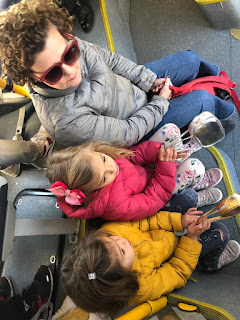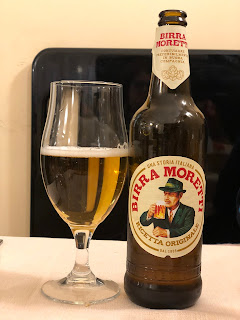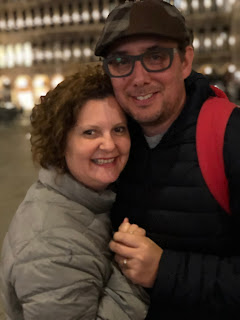It was tour group day with vovô and vovó. My parents are part of a month long tour with friends from their hometown in Brazil, travelling through Italy, Spain, Portugal and they will be going back to Brazil on a cruise ship crossing the Atlantic and visit some cities along the Brazil coastline. We tagged along with them for an organized tour in Venice. The girls loved being with their Brazilian grandparents and all their friends.
After going on a bus to Venice, we took a private boat to Piazza San Marco.
"Tia" Adriana was a trooper.
The former school teacher gave lots of attention - and candies! - to the girls.
Needless to say they LOVED her!
Tourists.
This is the Bridge of Sighs.
It has this name because people who were just convicted of a crime would cross this bridge between the courtroom and the prison and see the beauty of Venice - the water is on the other side - for the last time before being locked away.
The view from the Bridge of Sighs was the last view of Venice that convicts saw before their imprisonment. The bridge's name, given by Lord Byronas a translation from the Italian "Ponte dei sospiri" in the 19th century, comes from the suggestion that prisoners would sigh at their final view of beautiful Venice through the window before being taken down to their cells. In reality, the days of inquisitions and summary executions were over by the time the bridge was built, and the cells under the palace roof were occupied mostly by small-time criminals. In addition, little could be seen from inside the bridge due to the stone grills covering the windows.
(source: https://en.wikipedia.org/wiki/Bridge_of_Sighs)
Venice doesn't look like the Italy we had in mind.
Walking its narrow streets or navigating its canal, I kept thinking I was in an Arabic country.
The Doge's Palaca façade is an example of this islamic influence.
Islamic: inflected arches. This masterpiece of Venetian architecture clearly employs some Islamic elements. The inflected arches of the façade’s windows give the palazzi a distinctive Islamic feel. While the narrow profile of the windows and their arrangement is derived from Christian precedents, their inflected nature has Islamic inspiration. Also the stone or marble frame around the main floor windows – used for the first time in the Gothic period to highlight the importance of these central windows – might have been borrowed from the Islamic alfiz.
(source: https://www.approachguides.com/blog/venice-architecture-byzantine-islamic-influences/)
There is something special about the gondolas.
For its opulent design, gold ground mosaics, and its status as a symbol of Venetian wealth and power, from the 11th century on the building has been known by the nickname Chiesa d'Oro (Church of gold).
(source: https://en.wikipedia.org/wiki/St_Mark%27s_Basilica)
The Lion of Saint Mark, representing the evangelist St Mark, pictured in the form of a winged lion holding a Bible, is the symbol of the city of Venice and formerly of the Venetian Republic.
St Mark, represented as a lion, is derived from Mark’s description of John the Baptist as "...The voice of the one who cries in the wilderness: Prepare Ye the way of the Lord, make straight his paths.", which artists compared to a roaring lion. The wings come from Ezekiel 1:10 and the application of the prophet’s vision of four winged creatures to the evangelists. These appear again in Revelation 4:7.
A second connection of St. Mark and lions comes from a tale recounted by Severus Ebn-El-Mokafa: "Once a lion and lioness appeared to John Mark and his father Arostalis while they were traveling in Jordan. The father was very scared and begged his son to escape, while he awaited his fate. John Mark assured his father that Jesus Christ would save them and began to pray. The two beasts fell dead and as a result of this miracle, the father believed in Christ."
In some depictions the lion rests his front paws on the ground, often in cities with rivers or in ones close to water, indicating the Venetian balanced power on land and sea.
(source: https://en.wikipedia.org/wiki/Lion_of_Saint_Mark)
Pigeon feeding at Pizza San Marco.
The tour guide took us to a Murano Glass factory and store, where a glass maker made a demonstration of his work.
I don't have a picture of the final product, but Murano glass sculptures, jewellery and tableware are everywhere to be found.
Murano glass is made on the Venetian island of Murano, which has been a glassmaking center for over 700 years. It is also sometimes referred to as Venetian glass. Today Murano is known for its art glass, but it has a long history of innovations in glassmaking in addition to its artistic fame—and was Europe's first major glassmaking center. During the 1400s, Murano glassmakers created cristallo—which was almost transparent and considered the finest glass in the world. Murano glassmakers also developed a white-colored glass (milk glass called lattimo) that looked like porcelain. They later became Europe's finest makers of mirrors.
Murano became Europe's elite glassmaking center, peaking in popularity in the 15th and 16th centuries. Venice's dominance in trade along the Mediterranean Sea created a wealthy merchant class that was a strong connoisseur of the arts. This helped establish demand for art glass and more innovations. The spread of glassmaking talent in Europe eventually diminished the importance of Venice and its Murano glassmakers. A defeat by NapoleonBonaparte in 1797, and occupation, caused more hardship for Murano's glassmaking industry. Murano glassmaking began a revival in the 1920s. Today, Murano and Venice are tourist attractions, and Murano is home to numerous glass factories and a few individual artists' studios.
(source: https://en.wikipedia.org/wiki/Murano_glass)
Being silly with vovô and vovó just before we go for a Gondola ride.
Here it is! the so anticipated ride.
The six of us went in one gondola together, me in the back, across the Gondolier (the man who is "driving" the boat). I have to say that it wasn't quiet the experience I expected. I didn't feel too stable in the gondola, maybe because of I was sitting in the front, and any small movement felt like the gondola was going to overturn. I sat still the whole time, trying to keep the balance.
They seemed to be having a great time.
The gondola is a traditional, flat-bottomed Venetian rowing boat, well suited to the conditions of the Venetian lagoon. It is similar to a canoe, except it is narrower. It is propelled by a gondolier, who uses a rowing oar, which is not fastened to the hull, in a sculling manner and acts as the rudder.
For centuries, the gondola was a major means of transportation and the most common watercraft within Venice. In modern times, the boats still do have a role in public transport in the city, serving as traghetti (small ferries) over the Grand Canal operated by two oarsmen. For some years there were seven traghetti, but by 2017, the number had been reduced to three.
Various types of gondola boats are also used in special regattas (rowing races) held amongst gondoliers. Their primary role today, however, is to carry tourists on rides at fixed rates. There are approximately 400 licensed gondoliers in Venice and a similar number of boats, down from the thousands that travelled the canals centuries ago. However, they are now elegant craft, instead of the various types of shabby homemade boats of the distant past.
(source: https://en.wikipedia.org/wiki/Gondola)
My parents didn't care if we were there... they went for the romantic experience anyway.
Things felt even more unstable when we left the canals and went to the big body of water. The bigger boats were passing by and making waves. I just wanted to be closer to land.
Our friend's Gondolier.
A group cheer after the gondola ride. We survived!
The typical Venetian Gondolier.
The Rialto Bridge.
(source: https://en.wikipedia.org/wiki/Rialto_Bridge)
Parents on the Rialto Bridge.
There are many shops on the Rialto Bridge.
We went back to the Florian Cafe for coffee, tea, some biscuits and macaroons, of course!
One of the few pictures of myself, enjoying a delicious 5 o'clock tea.
A couple of musicians were playing classical music outside.
My parents and the kids started to dance.
Ok, Mike and I just followed them and dove into the romantic vibe.
Dinner time!
My parents took us out for dinner with the group to celebrate Mike's birthday.
It was fun to have a loud dinner with a bunch of people we hung out with all day.
That was also our goodbye from the group.
The local tour guide, Eliane, teaching Fifi how to eat pasta properly.
Happy birthday, meu amor! It's a big one!
The day ended up here for Mike and I, at the Bar Magic Number, a block away from the hotel.
We were exhausted, but it was nice to "go out" just the two for us for a drink and let my parents enjoy the last moments with the children back at the hotel. The next day, they were off to continue their trip in Europe. This is where we said goodbye.


























































